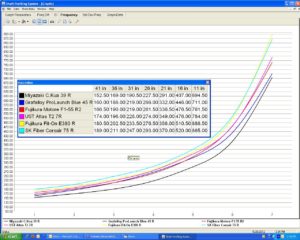Sometimes and then again, sometimes not. Sorry but that’s the truth because there are no standards in the golf industry for how stiff any of the letter flex codes are. Never have been and never will because the various golf companies don’t want that. So the R flex from one company can have the same stiffness as the S flex from another company or even the same stiffness as the A flex from a third company. Not only that, but the same flex of different shaft models within the SAME company is not necessarily going to be the same stiffness.
Sound a little confusing? Or a little bit like that’s not the way it should be?
Actually, it’s fine if each golf club company or shaft company wants to design their shafts different than another company. In doing that, they can express their own beliefs for each of their shafts should be designed.
What’s messed up is the fact that virtually none of these companies provide golfers with specific information to tell them exactly how stiff their shafts are in comparison to any other shafts. When it comes to flex, golfers are literally kept in the dark and have to adopt a “trial and error” means of determining how stiff this or that shaft is and whether it fits the golfer or not.
Since there are numerous shafts in the industry today that cost $100, $200, $300 and even more, a trial and error approach to shaft selection can get more than a little expensive. What’s the alternative? To put your shaft fitting needs in the hands of a custom Clubmaker who works with Tom Wishon Golf Technology’s proprietary shaft bend profile software.
In short, many years ago we saw the need for quantitative shaft stiffness information and created not only a measurement methodology for shaft stiffness, but a software program to allow all shafts in our data base to be compared in a way that you can definitely compare the stiffness design of many different shafts. As of mid 2012, we have over 2,000 different shafts in the TWGT Bend Profile software data base.
Here’s an example of what the information in the TWGT Bend Profile software looks like and how it works. The following data shows the range in stiffness among shafts which are sold and marked as R Flex in the golf industry today.
To translate what you are seeing, if we apply a swing speed rating to each shaft, you are looking at R flex shafts which range in swing speed rating from a 55-65mph shaft all the way up to a 110-120 mph shaft. The same goes on within all the S flex shafts in the industry as well.
Bottom line? If you want to be fit as accurately as possible for the shafts in your clubs, go get fit by a good, experienced custom Clubmaker. Especially a Clubmaker who uses this software in their shaft fitting. Clubmakers who use our TWGT Shaft Bend Profile software do a better job of fitting golfers and have a very high percentage of golfers who never have to go through an expensive trial and error process to find the best performing shaft for their swing.

